The National Oceanic and Atmospheric Administration warns of an impending record high heat across the nation. Last year was the warmest year on record for the globe, and we just experienced the warmest winter on record. With extreme heat comes…
Tag: Wildfire
U of I-Led Team Receives $15 Million to Study the Effects of Drought and Fires on Forests
A multidisciplinary team led by University of Idaho researchers has received a $15 million grant to study the long-term impact of drought and fire on forest ecosystems.
نصائح خبراء مايو كلينك لحماية رئتيك وسط أدخنة حرائق الغابات
عند اندلاع حرائق الغابات يواجه سكان المنطقة وفي بعض الأحيان المناطق خارجها، صعوبة متزايدة في التنفس. حيث تحمل الرياح الدخان لمسافة العديد من مئات الأميال من موقع الحريق الفعلي وفقًا لتصريح الطبيب كلايتون كاول، دكتور في الطب والذي يعمل كطبيب أمراض الرئة وعلم السموم الإكلينيكي في مايو كلينك.
UC Irvine researchers shine light on rapid changes in Arctic and boreal ecosystems
Irvine, Calif., April 16, 2024 — Arctic and boreal latitudes are warming faster than any other region on Earth. In three new studies, Earth system scientists at the University of California, Irvine report how the ecosystems in these regions are changing. In a study published in Global Change Biology, a team led by Earth system science Ph.
New report ‘braids’ Indigenous and Western knowledge for forest adaptation strategies against climate change
Severe droughts and wildfires, invasive species, and large insect outbreaks are straining national forests and surrounding lands. A new report outlines a new approach to forest stewardship that “braids together” Indigenous knowledge and Western science to conserve and restore more resilient forestlands in the U.S.
Cornell expands wildfire sensor coverage to every NY county
Nearly half of all New York counties lacked real-time information to determine air quality during the wildfire smoke days this past summer. Now, a Cornell researcher is leading an effort to install air-quality sensors in 28 upstate counties where there were none.

Extreme environments expert discusses causes of recent wildfires
Wildfires in Hawaii have devastated the island of Maui and leveled the historic town of Lahaina. As federal and local authorities investigate the causes of the disaster, questions have arisen about the effectiveness of government responses to the crisis.
Extreme environments expert discusses causes of recent wildfires
Wildfires in Hawaii have devastated the island of Maui. Canada continues to experience its worst ever wildfire season, with more than 1,000 active fires. Brian Lattimer, Director of Virginia Tech’s Extreme Environments and Materials Lab, explains what the Maui and Canadian wildfires have in common.
REBURN: A new tool to model wildfires in the Pacific Northwest and beyond
A new tool, REBURN, can simulate large forest landscapes and wildfire dynamics over decades or centuries under different wildfire management strategies.
Worsening wildfires have EMSL researchers looking for impact on soil, climate
Steven Allison, Professor of Ecology and Evolutionary Biology and Earth System Science, is using EMSL capabilities to uncover mysteries from the Earth beneath our feet. Allison explains how his research could help us understand severe events, like wildfire patterns, and how they affect soil microbiomes.
How animals are affected by Canadian wildfire smoke: University of Illinois expert available
URBANA, Ill. — Livestock and pets may be at risk due to poor air quality from Canadian wildfire smoke, according to animal welfare expert Angela Green-Miller at the University of Illinois Urbana-Champaign. Green-Miller is an associate professor in the Department…
Human-caused climate change to blame for increase in California’s wildfires
In the quarter century between 1996 and 2020, wildfires in California consumed five times more area than they did from 1971 to 1995. Researchers at the University of California and other international institutions have concluded that nearly all of the increase in scorched terrain can be blamed on human-caused climate change.
An AI tool that could help prevent wildfires
Wildfires are becoming more common, but machine learning can help cut them short
GW Experts Available: Smoke From Canadian Wildfires Remains Hazardous, Expands Reach
WASHINGTON (June 8, 2023)–The U.S. east coast continues to face hazardous and unhealthy air quality levels from Canada’s wildfires with many cities including New York, Philadelphia and Washington, D.C. experiencing the worst air quality in years. The National Oceanic and…
Wildfires in 2021 emitted a record-breaking amount of carbon dioxide
Carbon dioxide emissions from wildfires, which have been gradually increasing since 2000, spiked drastically to a record high in 2021, according to an international team of researchers led by Earth system scientists at the University of California, Irvine.
Understanding plants can boost wildland-fire modeling in uncertain future
A new conceptual framework for incorporating the way plants use carbon and water, or plant dynamics, into fine-scale computer models of wildland fire provides a critical first step toward improved global fire forecasting.
When cyclones and fires collide…
As strong winds and torrential rains inundate Australia’s south-eastern coast, new research suggests that high intensity bushfires might not be too far behind, with their dual effects extending damage zones and encroaching on previously low-risk residential areas.
Public policy and insurance expert to testify at House committee hearing on wildfire risk
Dean Matt Auer will testify as a witness for the House Financial Services Committee hearing entitled, “State of Emergency: Examining the Impact of Growing Wildfire Risk on the Insurance Market” on September 22 at 9:00 am
Tree Species in one of World’s Most Diverse Conifer Forests Not Migrating Uphill Fast Enough
The trees in Northern California’s Klamath Mountains are not keeping up with climate change. Instead, many tree species are in decline, losing the race due to climate warming and decades of fire suppression.
Study from “Black Tuesday” bushfires finds link to PTSD
New research published in the Australian Journal of Rural Health has shown people who are forced to relocate after a bushfire are at a higher risk of suffering from post-traumatic stress disorder, otherwise known as PTSD. Led by Associate Professor Venkatesan Thiruvenkatarajan from the University of Adelaide, and Dr Richard Watts from Flinders University, the researchers spoke with people affected by the 2005 “Black Tuesday” Eyre Peninsula bushfires, which took nine lives, destroyed 93 homes and blackened 80,000 hectares of land near Port Lincoln on 11 January, 2005.
Taming Tomorrow’s Wildfires
From uncovering where best to apply controlled burns to protecting energy infrastructure from outer space, scientists at PNNL are using their research to get an edge on tomorrow’s wildfires.
Department of Energy Announces $10 Million for Research on Environmental Systems Science
Today, the U.S. Department of Energy (DOE) announced $10 million in funding for 12 projects to universities, academic institutions, federal research labs, and nonprofits within the area of Environmental System Science (ESS) research. Grants will focus on studies intended to improve the understanding and representation of the impact of wildfires and floods on ecosystems and watersheds, as well the role of plant-mediated water redistribution and fungal networks in shaping ecosystem and watershed function.
Wildfires disproportionately affect the poor
With fires raging from California to Alaska, the 2022 wildfire season is off to a violent start. It’s an ominous sign of what promises to be another record-breaking fire season in the U.S. Roughly 2 million acres burned last month. And major fires are currently scorching Idaho, Utah and California, threatening tens of thousands of Americans’ homes and livelihoods. Many of those at risk are lower-income Americans who face canceled homeowners insurance policies and rising premiums, according to new research from the University of Georgia.
GW Experts Available to Discuss Extreme Weather and Climate Change
WASHINGTON (July 19, 2022) — Much of Europe has been hit by the latest record shattering heat wave. Such sweltering temperatures are part of global trends toward climate-fueled high temperatures that can lead to wildfires and damaging health consequences. The…
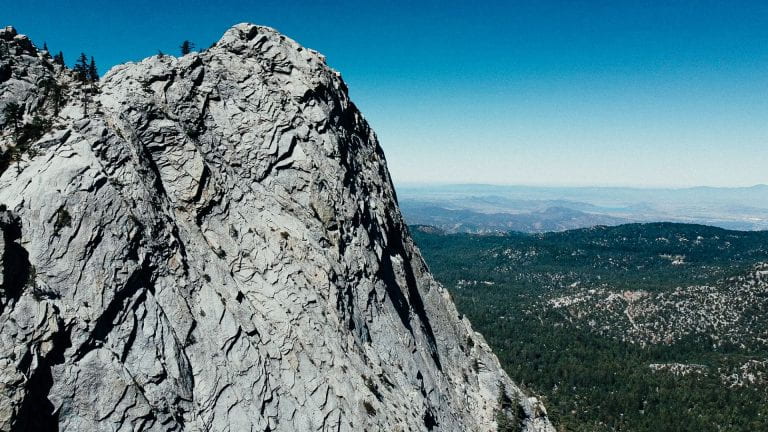
UCI study: California’s trees are dying, and might not be coming back
The State of California is banking on its forests to help reduce planet-warming carbon dioxide in the atmosphere. But that element of the state’s climate-change solution arsenal may be in jeopardy, as new research from the University of California, Irvine reports that trees in California’s mountain ranges and open spaces are dying from wildfires and other pressures – and fewer new trees are filling the void.
Experts available to discuss wildfire activity, ecosystem recovery and costs
With climate change leading to an increase in wildfires throughout the American Southwest, Northern Arizona University has a number of experts available to discuss the different facets of wildfires, forest health and restoration, and fire response. Ryan Fitch, assistant professor…
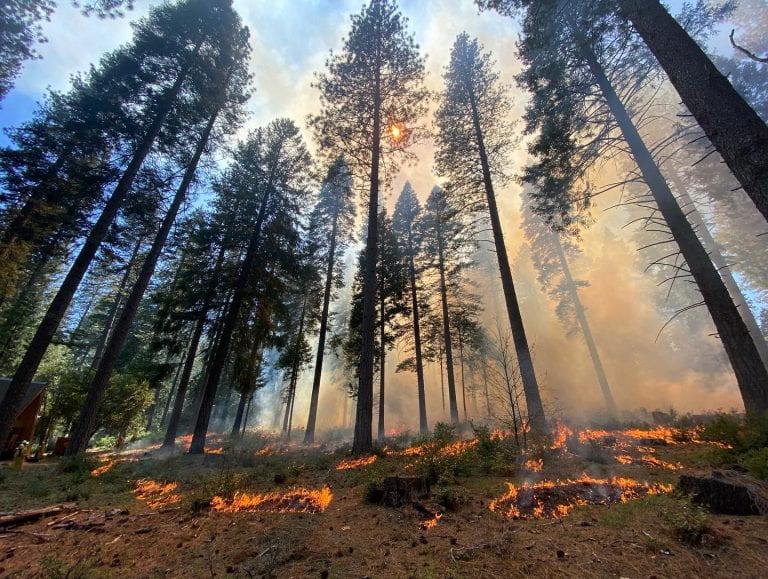
Human-triggered California wildfires more severe than natural blazes
Irvine, Calif., June 6, 2022 – Human-caused wildfires in California are more ferocious than blazes sparked by lightning, a team led by scientists from the University of California, Irvine reported recently in the journal Nature Communications. The research could help scientists better understand fire severity and how likely a blaze is to kill trees and inflict long-term damage on an ecosystem in its path.
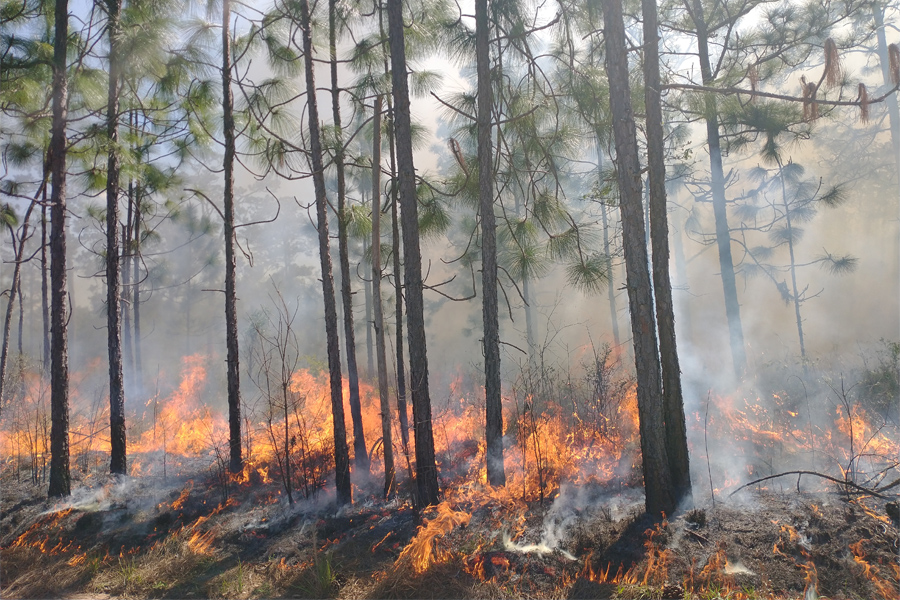
FSU expert investigating impact of prescribed burns
By: Bill Wellock | Published: May 23, 2022 | 4:38 pm | SHARE: Prescribed burns are an important tool for limiting the harmful effects of wildfires, but they require planning and proper conditions.The U.S. Forest Service recently announced a pause in the use of prescribed fire on National Forest System lands while the agency conducts a review of protocols and practices.
Forecasting Wildfires in an Unprecedented Time
With wildfires becoming stronger and more frequent, there is a need to predict when and how the next wildfire might occur. By examining statistical data of California’s wildfires dating back more than 60 years, Michael Mann, an associate professor of…
Immersive VR: empowering kids to survive in fire, flood, and war
When you live in the driest State in the driest country in the world, bushfires are an unfortunate, and all-too-regular part of life. Learning how to survive such emergencies is important for all people, but especially for our youngest citizens
After California’s 3rd-largest wildfire, deer returned home while trees were ‘still smoldering’
While many animals have adapted to live with wildfires of the past — which were smaller, more frequent and kept ecosystems in balance across the West — it’s unclear to scientists how animals are coping with today’s unprecedented megafires. A team of researchers tracked a population of black-tailed deer before, during and after the 2018 Mendocino Complex Fire and found that most of the deer returned home within hours of the fire, while trees were still smoldering.
Berkeley Lab Mobilizes to Predict How Caldor Fire May Lead to Floods and Land Movement
After the Caldor Fire erupted in August 2021, scientists from Berkeley Lab launched a research project to study how the fire would affect the mountain ecosystem, including factors such as streamflow, groundwater levels, water quality, and possible soil erosion leading to floods and debris flow. They mobilized to burn areas to collect samples of water, sediment, and ash.

FSU expert available to discuss wildfire modeling
By: Bill Wellock | Published: August 26, 2021 | 10:49 am | SHARE: Every summer, communities across the country are threatened by wildfires. To help firefighters and land managers mitigate the destructiveness of fires, one of the tools they use is modeling software that predicts what a fire is likely to do next.Bryan Quaife, an assistant professor in the Florida State University Department of Scientific Computing and a faculty associate in the Geophysical Fluid Dynamics Institute at FSU, studies fire modeling and fire dynamics.
How Wildfire Restored a Yosemite Watershed
For nearly half a century, lightning-sparked blazes in Yosemite’s Illilouette Creek Basin have rippled across the landscape — closely monitored, but largely unchecked.
Dryer, warmer night air is making some Western wildfires more active at night
Firefighters report that Western wildfires are starting earlier in the morning and dying down later at night, hampering their ability to recover and regroup before the next day’s flareup. A study shows why: The drying power of nighttime air over much of the Western U.S. has increased dramatically in the past 40 years.
Up in smoke
University of Utah researchers have developed a method to better predict if and when wildfire smoke might affect the ground-level air quality of nearby residents.
Possible future for Western wildfires: Decade-long burst, followed by gradual decline
A model of the eastern California forests of the Sierra Nevada looks at the longer-term future of wildfires under future climate change scenarios. Results show an initial roughly decade-long burst of wildfire activity, followed by recurring fires of decreasing area — a pattern that could apply to other drought-prone regions of the West.
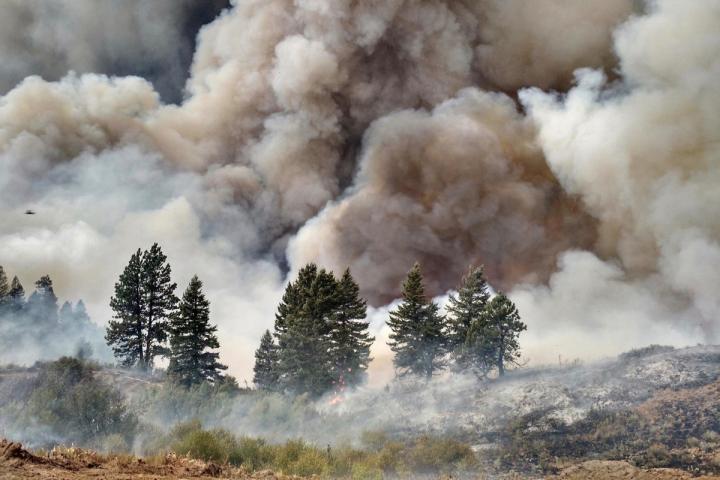
Wildfire Smoke Exposure Linked to Increased Risk of Contracting COVID-19
Wildfire smoke may greatly increase susceptibility to SARS-CoV-2, the virus that causes COVID-19, according to new research from the Center for Genomic Medicine at the Desert Research Institute (DRI), Washoe County Health District (WCHD), and Renown Health (Renown) in Reno, Nev.
As the U.S. Faces Lengthier Fire Seasons, Research Suggests Mental Health of Survivors Must be a Focus
Researchers say that government, public health agencies, and the public generally need to understand the mental health impacts of wildfire smoke as the world enters a time in which wildfire smoke events are prolonged events.
Disaster Response and Mitigation in an AI World
PNNL researchers are expanding PNNL’s operational Rapid Analytics for Disaster Response (RADR) image analytics and modeling suite to predict the path of fires, floods and other natural disasters, giving first responders an upper hand. The suite utilizes a combination of image-capturing technology (satellite, airborne, and drone images), artificial intelligence, and cloud computing, to not only assess damage but predict it as well.
Shelter from the storm
The new book “All Creatures Safe and Sound” examines how pets are managed during disasters and provides tips for keeping them safe. Sarah DeYoung, core faculty in the University of Delaware’s Disaster Research Center, talks about previous studies and the work that still needs to be addressed.
As Wildfires Increase in Severity, Experts Call for Coordinated Federal Response;
In advance of a wildfire season projected to be among the worst, the American Thoracic Society has released a report that calls for a unified federal response to wildfires that includes investment in research on smoke exposure and forecasting, health impacts of smoke, evaluation of interventions, and a clear and coordinated communication strategy to protect public health.
Wildfire smoke trends worsening for Western U.S.
New research from the University of Utah ties the worsening trend of extreme poor air quality events in Western regions to wildfire activity, with growing trends of smoke impacting air quality clear into September.
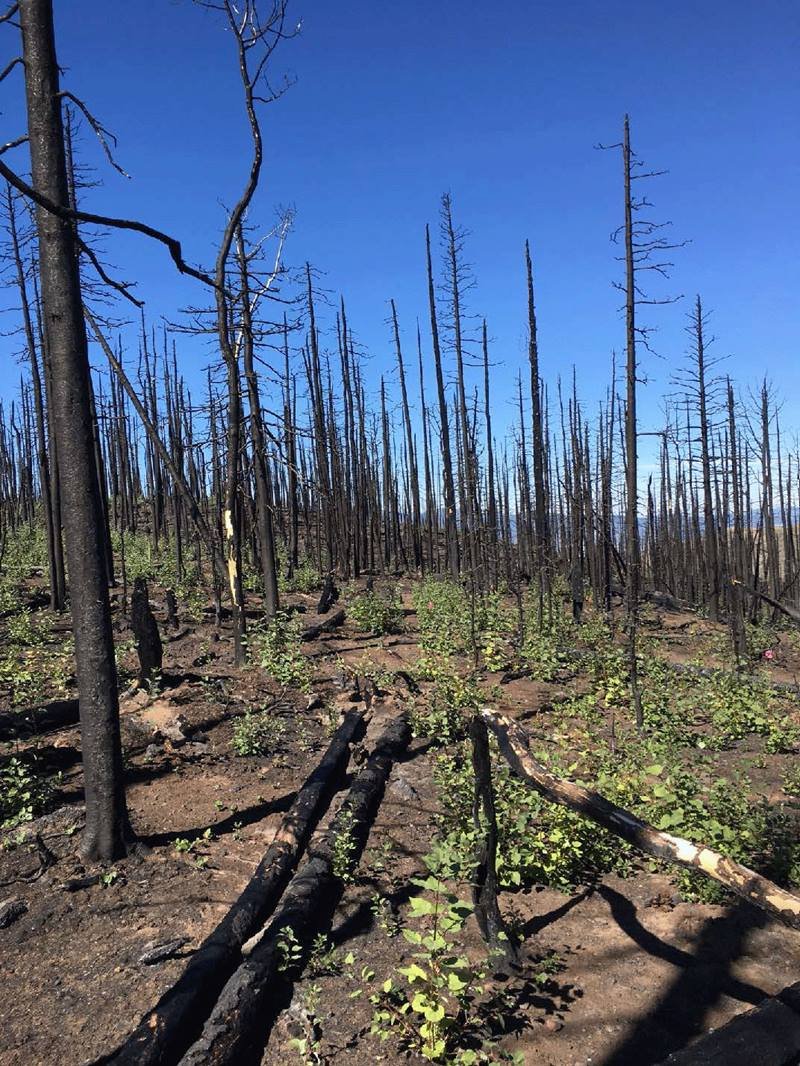
Burning the Forest, Not Just the Trees
Wildfires affect both the visible parts of plants and the plant microbiome. Understanding these effects helps scientists mitigate the effects of wildfires. This research examined microbial DNA samples from tissues of young quaking aspen saplings after a prescribed burn. Aspen relies largely on fire to regenerate. This work demonstrates that fire affects the entire plant microbiome, not just nearby soil.
The Race Against the Climate Crisis
Just adapting to climate change is not something the world can afford to do. So, the CSU is exploring all options to thwart potentially disastrous consequences.
From Smoky Skies to a Green Horizon: Scientists Convert Fire-Risk Wood into Biofuel
Reliance on petroleum fuels and raging wildfires: Two separate, large-scale challenges that could be addressed by one scientific breakthrough. Researchers from two national laboratories have collaborated to develop a streamlined and efficient process for converting woody plant matter like forest overgrowth and agricultural waste – material that is currently burned either intentionally or unintentionally – into liquid biofuel.

How outdoor pollution affects indoor air quality
In a long-term study in a Salt Lake-area building, researchers found that the amount of air pollution that comes indoors depends on the type of outdoor pollution. Wildfires, fireworks and wintertime inversions all affect indoor air to different degrees.
DHS Trains California Fire Services on Situational Awareness Application
DHS S&T recently conducted a virtual training on its Team Awareness Kit (TAK) that provides such features as video sharing, location tracking of fire equipment, fire perimeters from aircraft, and fire model forecasts.
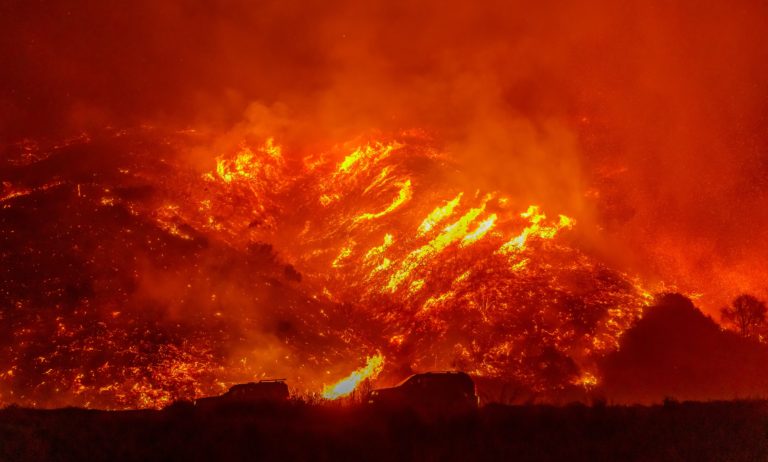
UCI, Tsinghua U.: California’s 2018 wildfires caused $150 billion in damages
Irvine, Calif., Dec. 7, 2020 — In 2018, California wildfires caused economic losses of nearly $150 billion, or about 0.7 percent of the gross domestic product of the entire United States that year, and a considerable fraction of those costs affected people far from the fires and even outside of the Golden State. For a study published today in Nature Sustainability, researchers at the University of California, Irvine, China’s Tsinghua University and other institutions combined physical, epidemiological and economic models to gain a more comprehensive understanding of the impact of the blazes.

In fire-prone West, plants need their pollinators — and vice versa
2020 is the worst fire year on record in the United States. In the face of heartbreaking losses, effort and expense, scientists are still grappling with some of the most basic questions about how fire influences interactions between plants and animals in the natural world. A new study grounded in the northern Rockies explores the role of fire in the finely tuned dance between plants and their pollinators.